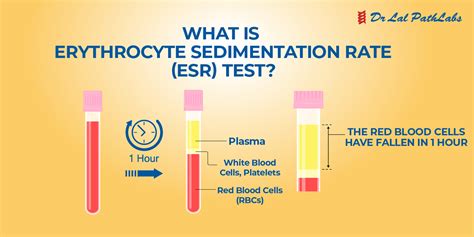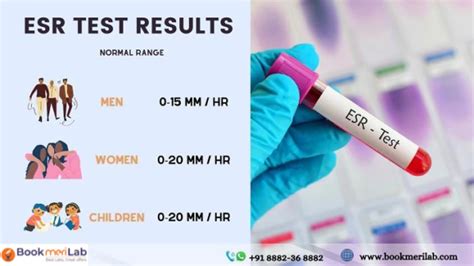Intro
Discover the significance of Lab Work ESR Tests, including Erythrocyte Sedimentation Rate, blood tests, and inflammation diagnosis, to understand disease severity and monitor treatment efficacy.
The importance of laboratory tests in diagnosing and managing various medical conditions cannot be overstated. Among the numerous tests that healthcare professionals rely on, the Erythrocyte Sedimentation Rate (ESR) test is a widely used and informative tool. The ESR test, also known as the sedimentation rate or sed rate, measures how quickly erythrocytes (red blood cells) settle at the bottom of a test tube containing a blood sample. It indirectly measures how much inflammation is in the body. Understanding the ESR test is crucial for both healthcare providers and patients, as it can provide valuable insights into the presence and severity of inflammation, which is a key component of many diseases.
Inflammation is the body's natural response to injury or infection, and it can be either acute or chronic. Acute inflammation is a short-term response that occurs in reaction to an immediate threat, such as a cut or a bacterial infection. Chronic inflammation, on the other hand, is a long-term response that can lead to various health problems, including autoimmune diseases, cardiovascular disease, and cancer. The ESR test is a non-specific marker of inflammation, meaning it can indicate the presence of inflammation but does not identify the cause. Therefore, it is often used in conjunction with other diagnostic tests to determine the underlying condition causing the inflammation.
The ESR test has been a staple in clinical practice for many decades, and its applications continue to evolve. It is commonly used to diagnose and monitor conditions such as rheumatoid arthritis, lupus, and other autoimmune diseases. Additionally, the ESR test can help healthcare providers monitor the effectiveness of treatments and detect potential complications. Despite its widespread use, the ESR test is not without limitations. For example, it can be influenced by various factors, including age, gender, and the presence of certain medical conditions. Therefore, interpreting the results of an ESR test requires careful consideration of the individual patient's context.
How ESR Tests Work

The ESR test works by measuring the rate at which erythrocytes settle in a test tube. The test is typically performed on a blood sample that has been treated with an anticoagulant to prevent clotting. The blood sample is then placed in a vertical test tube, and the rate at which the erythrocytes settle is measured over a period of time, usually one hour. The results are reported in millimeters per hour (mm/h). A higher ESR indicates a greater degree of inflammation, as the presence of inflammatory proteins in the blood causes the erythrocytes to clump together and settle more quickly.
Factors Influencing ESR Results
Several factors can influence the results of an ESR test, including: * Age: ESR increases with age, so older adults may have higher ESR results even in the absence of inflammation. * Gender: Women tend to have higher ESR results than men, particularly during pregnancy and menstruation. * Medical conditions: Certain conditions, such as anemia, kidney disease, and liver disease, can affect ESR results. * Medications: Some medications, such as corticosteroids and nonsteroidal anti-inflammatory drugs (NSAIDs), can suppress inflammation and reduce ESR results.Benefits of ESR Tests

The ESR test has several benefits that make it a valuable tool in clinical practice. Some of the key benefits include:
- Non-invasive: The ESR test is a simple blood test that does not require any invasive procedures.
- Low cost: The ESR test is relatively inexpensive compared to other diagnostic tests.
- Quick results: ESR test results are typically available within a few hours, allowing for rapid diagnosis and treatment.
- Monitoring disease activity: The ESR test can be used to monitor disease activity and response to treatment in conditions such as rheumatoid arthritis and lupus.
Common Applications of ESR Tests
The ESR test has a wide range of applications in clinical practice. Some of the common uses of the ESR test include: * Diagnosing and monitoring inflammatory diseases, such as rheumatoid arthritis and lupus. * Detecting infections, such as bacterial and viral infections. * Monitoring disease activity and response to treatment in conditions such as cancer and cardiovascular disease. * Screening for underlying medical conditions in patients with non-specific symptoms, such as fatigue and weight loss.Interpreting ESR Results

Interpreting the results of an ESR test requires careful consideration of the individual patient's context. The normal range for ESR results varies depending on the laboratory and the individual's age and gender. In general, a normal ESR result is considered to be:
- 0-20 mm/h for adults
- 0-15 mm/h for children
- 0-10 mm/h for infants
A high ESR result indicates the presence of inflammation, but it does not identify the underlying cause. Therefore, additional diagnostic tests and clinical evaluation are necessary to determine the cause of the inflammation.
Limitations of ESR Tests
While the ESR test is a valuable tool in clinical practice, it has several limitations. Some of the key limitations include: * Non-specific: The ESR test is a non-specific marker of inflammation, meaning it can indicate the presence of inflammation but does not identify the cause. * Influenced by various factors: ESR results can be influenced by various factors, including age, gender, and medical conditions. * Limited sensitivity: The ESR test may not detect mild or early inflammation, and it may not be sensitive enough to detect certain types of inflammation.Comparison with Other Inflammatory Markers

The ESR test is often used in conjunction with other inflammatory markers, such as C-reactive protein (CRP) and fibrinogen. These markers can provide additional information about the presence and severity of inflammation. CRP is a protein that is produced by the liver in response to inflammation, and it is a more sensitive marker of inflammation than ESR. Fibrinogen is a protein that is involved in blood clotting, and it can also be used as a marker of inflammation.
Advantages and Disadvantages of Other Inflammatory Markers
Each inflammatory marker has its advantages and disadvantages. Some of the key advantages and disadvantages of other inflammatory markers include: * CRP: + Advantages: More sensitive than ESR, can detect mild or early inflammation. + Disadvantages: More expensive than ESR, may not be available in all laboratories. * Fibrinogen: + Advantages: Can be used as a marker of inflammation and blood clotting. + Disadvantages: May not be specific for inflammation, can be influenced by various factors.What is the normal range for ESR results?
+The normal range for ESR results varies depending on the laboratory and the individual's age and gender. In general, a normal ESR result is considered to be 0-20 mm/h for adults, 0-15 mm/h for children, and 0-10 mm/h for infants.
What are the benefits of ESR tests?
+The ESR test has several benefits, including being non-invasive, low-cost, and quick results. It can also be used to monitor disease activity and response to treatment in conditions such as rheumatoid arthritis and lupus.
What are the limitations of ESR tests?
+The ESR test has several limitations, including being non-specific, influenced by various factors, and limited sensitivity. It may not detect mild or early inflammation, and it may not be sensitive enough to detect certain types of inflammation.
In conclusion, the ESR test is a valuable tool in clinical practice that can provide valuable insights into the presence and severity of inflammation. While it has several benefits, including being non-invasive and low-cost, it also has limitations, such as being non-specific and influenced by various factors. By understanding the benefits and limitations of the ESR test, healthcare providers can use it effectively in conjunction with other diagnostic tests to diagnose and manage various medical conditions. We encourage readers to share their thoughts and experiences with ESR tests in the comments below, and to explore other related topics on our website.
